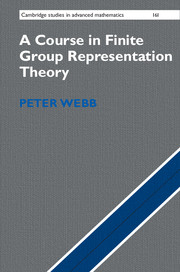Book contents
- Frontmatter
- Contents
- Preface
- 1 Representations, Maschke's Theorem, and Semisimplicity
- 2 The Structure of Algebras for Which Every Module Is Semisimple 15
- 3 Characters
- 4 The Construction of Modules and Characters
- 5 More on Induction and Restriction: Theorems of Mackey and Clifford
- 6 Representations of p-Groups in Characteristic p and the Radical
- 7 Projective Modules for Finite-Dimensional Algebras
- 8 Projective Modules for Group Algebras
- 9 Changing the Ground Ring: Splitting Fields and the Decomposition Map
- 10 Brauer Characters
- 11 Indecomposable Modules
- 12 Blocks
- Appendix A Discrete Valuation Rings
- Appendix B Character Tables
- Bibliography
- Index
1 - Representations, Maschke's Theorem, and Semisimplicity
Published online by Cambridge University Press: 05 August 2016
- Frontmatter
- Contents
- Preface
- 1 Representations, Maschke's Theorem, and Semisimplicity
- 2 The Structure of Algebras for Which Every Module Is Semisimple 15
- 3 Characters
- 4 The Construction of Modules and Characters
- 5 More on Induction and Restriction: Theorems of Mackey and Clifford
- 6 Representations of p-Groups in Characteristic p and the Radical
- 7 Projective Modules for Finite-Dimensional Algebras
- 8 Projective Modules for Group Algebras
- 9 Changing the Ground Ring: Splitting Fields and the Decomposition Map
- 10 Brauer Characters
- 11 Indecomposable Modules
- 12 Blocks
- Appendix A Discrete Valuation Rings
- Appendix B Character Tables
- Bibliography
- Index
Summary
In this chapter, we present the basic definitions and examples to do with group representations. We then prove Maschke's theorem, which states that in many circumstances representations are completely reducible. We conclude by describing the properties of semisimple modules.
Definitions and Examples
Informally, a representation of a group is a collection of invertible linear transformations of a vector space (or, more generally, of a module for a ring) that multiply together in the same way as the group elements. The collection of linear transformations thus establishes a pattern of symmetry of the vector space, which copies the symmetry encoded by the group. Because symmetry is observed and understood so widely, and is even one of the fundamental notions of mathematics, there are applications of representation theory across the whole of mathematics as well as in other disciplines.
For many applications, especially those having to do with the natural world, it is appropriate to consider representations over fields of characteristic zero such as C, R, or Q (the fields of complex numbers, real numbers, or rational numbers). In other situations that might arise in topology or combinatorics or number theory, for instance, we find ourselves considering representations over fields of positive characteristic, such as the field with p elements Fp, or over rings that are not fields, such as the ring of integers Z. Many aspects of representation theory do change as the ring varies, but there are also parts of the theory that are similar regardless of the field characteristic or even if the ring is not a field. We develop the theory independently of the choice of ring where possible so as to be able to apply it in all situations and to establish a natural context for the results.
Let G denote a finite group, and let R be a commutative ring with a 1. If V is an R-module, we denote it by GL(V) the group of all invertible R-module homomorphismsV →V. In case,V ≅ Rn is a free module of rank n, this group is isomorphic to the group of all nonsingular n × n matrices over R, and we denote it by GL(n, R) or GLn(R), or in case R = Fq is the finite field with q elements by GL(n, q) or GLn(q).
- Type
- Chapter
- Information
- A Course in Finite Group Representation Theory , pp. 1 - 14Publisher: Cambridge University PressPrint publication year: 2016



